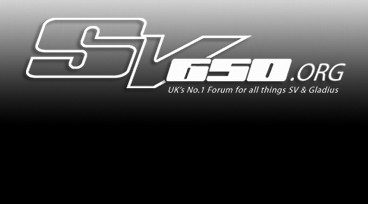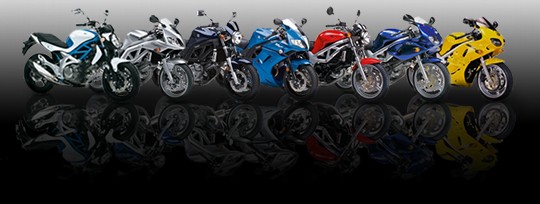 |
 |
|
|
#31 |
|
Moderator
Mega Poster
Join Date: Jan 2004
Location: In the garage where I belong
Posts: 17,083
|
My explanation: Torque is how much you shove, power is how often you do it. A high-power, low torque bike (ie, a screamer, like a new R6) makes a huge amount of small pushes, while a lazy twin (say, a big Harley) makes a small amount of huge pushes. The difference between tapping in a nail and whacking it in, really.
If you want, you can redo that explanation and make it really dirty. If you want. Anyhoo. I do agree that it's more or less irrelevant. A bike that makes 50bhp at 5000rpm looks, on paper, better than one that does it at 10,000rpm, but all other things being equal the difference is irrelevant to the riding experience. Where it all goes wrong is that people see that, say, the R6 makes no torque at 8000rpm compared to an SV, and think that makes it inferior- but it's not a fair comparison, at 8000rpm an SV is 4/5 up the revs, while the R6 is only half way. You get a better comparison when you make the X axis non-numerical- ie, you put 0 revs at one end, maximum revs at the other, half revs in the middle.
__________________
"We are the angry mob, we read the papers every day We like what we like, we hate what we hate But we're oh so easily swayed" |
|
|

|
|
|
#32 | |
|
Moderator
Mega Poster
Join Date: Jan 2004
Location: In the garage where I belong
Posts: 17,083
|
Quote:
__________________
"We are the angry mob, we read the papers every day We like what we like, we hate what we hate But we're oh so easily swayed" |
|
|
|

|
|
|
#33 |
|
Guest
Posts: n/a
|
Northwind, it might be obvious to you, but it doesn't seem to be to others judging by some of the posts. My point to dotted is that torque numbers don't matter at all, and should be ignored. Acceleration of the bikes has to do with power and the spread of power. What you feel is the power. Torque is needed for the engineers who design the gearboxes!
|

|
|
|
#34 |
|
Moderator
Mega Poster
Join Date: Jan 2004
Location: In the garage where I belong
Posts: 17,083
|
They represent the same thing, power and torque. Just expressed slightly different. It makes no more sense to say "ignore engine torque" than to say "ignore engine power", since power in hp is just (torque in lb/ft x rpm) /5252
It's like saying "Forget about how many pounds you just spent, pounds are irrelevant- pennies are what counts"
__________________
"We are the angry mob, we read the papers every day We like what we like, we hate what we hate But we're oh so easily swayed" |
|
|

|
|
|
#35 |
|
Guest
Posts: n/a
|
Northwind, just because they are mathematically related does not mean they mean the same thing. When you are riding and you hit the the revs that your bike pulls (accelerates) the best you could do some maths in your head and say to yourself 'hmm, I bet the torque curve peaked 2,500rpm ago. But why would you? How does it help you in the slightest? Knowing where the peak torque is and what the number happens to be is nowhere near as useful as looking at the shape of the power curve.
|

|
|
|
#36 |
|
Moderator
Mega Poster
Join Date: Jan 2004
Location: In the garage where I belong
Posts: 17,083
|
Nah, I disagree entirely with that. It depends entirely on what you're looking to find. For instance, the SV's hole in the midrange is shining bright on a torque curve but not nearly so clear on power. But you can feel that hole all right.
If all you want to see is "where does peak acceleration live" then I agree that power's what you need to be checking, but that's far from the only relevant detail when gauging an engine's performance. Torque curves (when seperated from the numbers) tell you more about the character of an engine at a glance.
__________________
"We are the angry mob, we read the papers every day We like what we like, we hate what we hate But we're oh so easily swayed" |
|
|

|
|
|
#37 |
|
Guest
Posts: n/a
|
On the dyno chart above it seems obvious to me that the midrange dip is on the power curve just as much as the torque curve - but since they are directly mathematically related that is to be expected. What could be more useful is various part throttle charts that would represent regular riding a bit better.
The power curve tells all. Okay, let me ask you this: If you had never ridden an SV before and all you saw was the torque curve, how would you think the bike would behave at 3,500 rpm or at 10,000? I could make this a lot more interesting by finding some torque curve charts and removing the bike names from them and seeing what could be gleened from them. And then do the same with power charts. Which would give you the best feel for the bike concerned? I might actually do this for a bit of fun later... |

|
|
|
#38 |
|
Moderator
Mega Poster
Join Date: Jan 2004
Location: In the garage where I belong
Posts: 17,083
|
I look at the torque curve and see that it'll pull from 3500, as the torque is pretty stable from there up. You can see at a glance that the bike's got a very wide usable rev band, with a good torque curve from 3000 up.
But look at the power curve, and you can see that it's making around 25bhp. Not very informative. It tells you very little about how the engine compares at different revs- you can see it's fairly linear, and fairly smooth, but without experience it's hard to relate that to real-world feel- especially on an unfamiliar bike. But a single look at the torque tells you that it's going to give a comparable delivery all the way from 3000 to just shy of 6000, then pick up. To get the same information from the power curve you have to compare climb rates, perfectly doable but not so clear. The dip in the midrange can be seen on the power curve, as I said. But it's very obvious on the torque curve, whereas on the power curve it's just a slight slowing of climb- it'd be far less obvious without the helpful line showing what happens when you remove it. You need more riding experience to get meaningful information from a power curve than a torque curve, IMO. At what point does a bike become rideable, stop juddering? 20bhp? 30bhp? Who knows. But, when you see the SV's torque curve you know at once that it's going to be usable all over from 3000 up. You seem to be thinking I'm attacking the usefulness of the power curve- I'm not at all. It's very useful. It's just not the only game in town.
__________________
"We are the angry mob, we read the papers every day We like what we like, we hate what we hate But we're oh so easily swayed" |
|
|

|
|
|
#39 |
|
Guest
Posts: n/a
|
Ok... i get that torque is the stuff that makes you grin , sinse we humans can only fell acceleration , to fly on an an air-plane isnt to exiting , even if its moving at 800km/h.
And what makes de SV a fun bike , is that it has a very good acceleration(torque) at the all the lower/mid rev range. Sport's IL4 on the other hand , have the fun zone at the higher rev range ! FZ6 power curve : http://www.sitogroup.com/pls/pazsito...-7153-7154.jpg R6 power curve : http://www.sitogroup.com/pls/pazsito...-7579-7580.pdf SV power Curve : http://www.sitogroup.com/pls/pazsito...1_SV650_04.jpg ps: I not getting any regrets for choosing an SV over an 100bhp IL4 , i did study a lot before choosing my bike , and the SV is all that i wanted in a bike , fun and sporty, and having ride an FZ6 , only made me more happy with my choice |

|
|
|
#40 | |
|
Guest
Posts: n/a
|
Quote:
You can't feel acceleration, or speed. What you feel is Torque. Torque is a FORCE. I have a physics degree so at last its something I know about. I'll try and make this as easy to understand as I can. Torque is a FORCE that rotates or turns things. It is a ROTATIONAL force. If you use a spanner to turn a bolt then you create a FORCE - e.g. pushing on the spanner. This creates a TORQUE on the bolt which TURNS or ROTATES the bolt. Now if it takes 1 minute to turn the spanner round ONE revolution then this is 1RPM You obviously need power to impart force on the spanner. This is HORSEPOWER (HP) Horsepower - this was derived from James Watts experiments involving a Clydesdale horse and a 550 pound weight. Basically a horse could carry a 550 weight 1 foot in 1 second. Horsepower is measured in feet per pound or "foot pounds". 1 hp = 746 watts (Just accept it - the derivation is too long and involves maths) Now for motorbikes/cars etc, we need to measure units of force from rotating components such as crankshafts. This turning force again is TORQUE meausred in foot pounds. Northy's right by the way on Torque curves: NO ONE measures horsepower from a running engine. What we do measure is the TORQUE (using a DYNOMETER) in foot pounds, then we calculate the HP from the TURNING FORCE or Torque. Its the most important factor. A bike will accelerate best at its torque peak in any gear. It wont accelerate as hard below or above that peak. Torque is the only thing that you feel. You can't feel horsepower or acceleration as these aren't forces. Say you made 500 foot pounds of torque 2000 rpm... Then... Say you made 500 foot pound of torque at 4000 rpm you would accelerate just the same at both RPM but would be DOUBLE the horsepower at 4000 RPM Work it out using the formula below. HP = TORQUE x RPM ------------------ 5252 Anyway - IL4s v SVs Much better to make torque at high rpm than at low rpm. All to do with gearing but thats another argument. |
|

|
 |
|
|
 Similar Threads
Similar Threads
|
||||
| Thread | Thread Starter | Forum | Replies | Last Post |
| Please, someone, explain this! | thedonal | Idle Banter | 15 | 14-12-08 05:10 PM |
| can someone explain this please? | guzz316 | SV Talk, Tuning & Tweaking | 8 | 29-09-08 08:32 PM |
| Please explain this to me. | Pedrosa | Idle Banter | 12 | 03-11-07 12:26 PM |
| Anyone care to explain..... | Nexus242 | Idle Banter | 2 | 18-05-06 04:53 AM |
| explain pls | Wiltshire7 | SV Talk, Tuning & Tweaking | 26 | 16-11-04 11:29 PM |